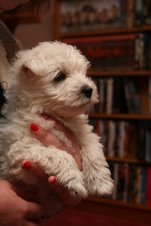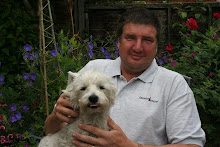All through the recent snowfalls, pretty though they were, we have not had any really cold weather. Under that snow, as your boot heel squeaked down through it, you could feel the mud still yielding and 'fudge' soft. Where we did get a bit of a crunchy surface crust it was very thin and had softened by midday as the sun turned the grass back to green from white. Well, not this time. Over the last few nights the air has gone down to the -4's and -6's and with the wind chill factor it has been bitter-raw.
 |
| This is a bit crunchy, Dad! Can we have some wet stuff? |
The sheep are OK with their straw shelter (though I did tie some more sheeting to the fence to stop a 'knife' of WNW wind taking the noses off the poor things as they ate from the trough). The birds are all OK in their solid buildings - a bit draughty maybe but not actually windy. I lashed up some of the big 40 kg coal sacks to the North side of the giant rabbits' run to give them some protection. I am also obviously into carrying out liquid water to the anybody whose drinker is solid, the geese in particular. Blue has been able to try out his pond-skating skills again.
 |
That's more like it. The geese make do with a bucket of fresh
indoor water. |
The main pond is a sheet of bobbly ice, where falling snow has landed and floated, combining to form the top-crust. I used to doubt those experts who'd look at the sky and say "too cold for snow" (I'm fairly sure it snows at both poles!) but that does seem to be the way of it here, or perhaps it is truer to say that it only gets really cold along this Atlantic margin, when we have high pressure and no clouds. Me personally, I enjoy the fact that it is frozen and 'dry' rather than the sloppy mud we have had some years. I love that stage where the puddles crust over with ice but then contract back into the earth. leaving the top-crust hanging there, above ground, fixed to a few blades of crisp grass.
 |
| Frozen puddle. |
Our grass remains intact this year and has not been reduced to square yards of brown slop where humans have walked, geese have paddled and chickens have scraped. The exponents of wildlife gardening and helping the pollinators, of course, advocate planting plenty of very early flowering plants so that the bees have something to get at if they emerge early. These lists generally include snow drops, crocus and the flowering currents (
Ribes) and pussy willow and hazel for the catkins. We are getting there. We are struggling to source snowdrops "in the green" as we used to do in Kent but have planted some dry and rather unlikely looking bulbs. We have planted a good few crocus each year into the lawn, though the 2014 batch have come up just as the snow hit and are now the must-have breakfast choice for one of the Buff Orp young roosters. The poor things are looking a bit ravaged. However, the bees have also been hunkered down in the hive since 25th January, so they've not needed the crocus flowers.
 |
| A frozen wash-out? Autumn sown broad beans. |
In Kent, too, I was always able to grow autumn-sown broad beans. I would get them into the ground in October and they would emerge and grow to be sturdy 3-6 inch tall plants by the time the cold weather came. They would then go alarmingly limp and sorry looking at every frost but would bounce back well as the frost cleared and steam on through spring to produce a lovely early crop in May/June before the black fly had even spotted them. I was advised not to bother here and I know that Mentor Anne has done trials and now stopped trying; she does them in early spring now using root trainers and does not bother with the autumn sown varieties.
 |
| The rather ravaged crocus. |
The plants do not like the constant wet. I suspect they could cope if it was just cold, but the wet, wet, wet has the biggest leaves turning black and falling away so that the poor lads either die or struggle on as a weak looking stem and tiny leaves which never really get cracking in the spring. I had three good rows going into the winter and great hopes for them, but I am now reduced to half a dozen plants and lots of gaps plus a conviction that the advice was correct. 2 failed winters. Life's too short. We always garden to our strengths anyway and never try to force things to grow which need 'the wrong soil' or shade/full sun or what-ever. Every day's a school day.
 |
| Purple sprouting broccoli, ready soon. |
We do seem to be able to grow all the kales, cabbages and broccolis. I have a lovely stand of purple sprouting broccoli out there at present which has gone through winter with its sprout-buds tightly closed and tiny and is now starting to move; well, it was till these -6ºC temperatures came along. A warm week or two and we will be able to start cutting that and bringing it into the kitchen. The Brussels sprouts are nearly done, with just a few tiny buds left at the tops of the stems and, again, a warm week might let those expand a bit.
Talking of 'frozen', everyone was a winner yesterday when we dug a pork shoulder joint out of the freezer but decided to make a curry of the lean meat having first boned it out and stripped off the skin and subcutaneaous fat. Raw pork bones are our dogs' absolute favourite (and the best
for them, it seems; no upset stomachs, that 'lovely' white chalky poo) and there were three good chunks for the three dogs. I skimmed the skin off the fat and roasted it into 'scratchings' for dog treats and the fat, finely diced, was hoovered up by the frosty chickens. The curry was a Madhur Jaffrey "Goan hot and sour" which we served with white rice and home made Naan bread.
 |
| Ear tags and pliers. |
Finally, our sheep ear-tag 'pliers' and first batch of ear tags turned up. Under EU rules we have to identity-tag every sheep and lamb we 'produce' on this 'farm' before it leaves (even to the mart or for slaughter) the premises or before it reaches 9 months of age. There are, of course, standard designs of tags you must use and you have to buy them from proper official suppliers who hold the databases of sheep flocks in their patch, in our case the excellent Mullinahone Co-op (Tipperary) who also supplied our pig 'slap-mark' numbers.

As you sign on with them as a customer, they pull up your details and start a sequence of ear-tag numbers; always here, the letters IE (for Ireland), then 04 (species code for sheep), followed by a 5 digit flock ID - I am 55809 and then 5 digits and a random letter for the animal number. You start at 00001 and off you go. Liz spotted a charming coincidence, that our first lamb (so IE0455809-00001F, to his friends) happens to have the random letter 'F' - his name is Feste. Our first batch of tags was the minimum size, 10 tags. It may take us a while to get through them at this rate even if the girls knock out some pairs of twins. We feel all grown up and official now in our 'farming'.












2 comments:
What we had said Matt was that we had done a trial to compare autumn sown seeds with those sown in the spring and that we had found no difference in either vigour or yield or blackfly attack. The seeds planted in January and planted out in late March caught up with the winter sown ones. Planting in the spring makes it less likely that mice or rats will come along and eat the seeds if there is cold weather.
Thanks for that.
Post a Comment